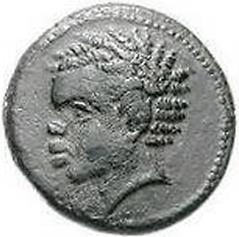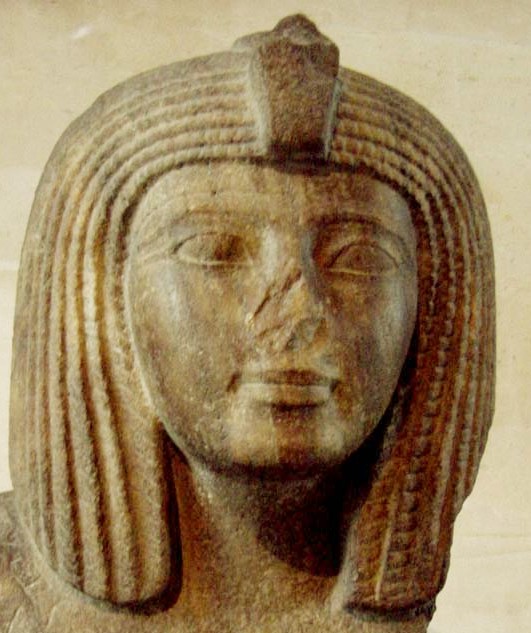 Hannibal Barca, the greatest military leader and strategist of all time, was born in 247 B.C. when Carthage was on the decline.
Hannibal Barca, the greatest military leader and strategist of all time, was born in 247 B.C. when Carthage was on the decline.
Hannibal the Great accompanied his father Hamilclar in a battle against the Romans when he was very young, and after succeeding his father, he became the supreme commander of the peninsula seventeen years later. Here is the real face of Hannibal the Great preserved on one of his coins found in the Clanis Valley, Italy around 207 B.C.
Hannibal, the North Afrikan Hercules, is the Black man who was hailed by scholars and military historians as the father of military strategy. Hannibal performed the astounding feat of marching his army and war elephants through the Alps to surprise and defeat his enemies in 218 B.C. With only 26,000 of his original force of 82,000 troops, he defeated Rome which at the time was the mightiest military power with an army of a million men. For the next fifteen years Rome was defeated in every battle it undertook.
Hannibal’s tactics are still taught today in leading military academies of the U.S.A., Europe and other lands, and to this day his genius as a strategist, warrior, statesman and economist, along with his example of moral courage, is still an example that should be emulated by all members of the Afrikan, Afro-American, West Indian and Black Communities across the globe.
In one battle led by Scipio, the Romans put 80,000 men on the battle grounds to defeat Hannibal. When Scipio attacked with his entire army, Hannibal, who had studied the layout of the field, had organized his men in a formation to surround the Romans. He then turned his war elephants loose and crushed them first before sending in his Afrikan swordsmen behind them to complete the slaughter.
Scipio Afrikanus admired and praised his noble enemy, and the two adversaries developed a friendship.
In another battle, Rome sent 90,000 men led by Varro and Emilius. Hannibal, with just 50,000 men, placed the weakest division of his army in the centre contrary to the best military principles, after realizing that he could not win if he had used his main force. With his veterans and cavalry on both wings, the Romans attacked in the centre just as Hannibal had strategized. When the Romans were sure of a victory by overwhelming the centre force, Hannibal's flank then closed in and killed 70,000 men which included 80 senators including Emilius.
“Hannibal was described as a tall man of exceptional physical strength, endurance, skill as an athlete and soldier. The men who served under his command admired his superior martial art skills and his willingness to endure the same hardships that they were faced with. These physical and mental characteristics made him stand out high above all the others”.
Hannibal possessed extraordinary courage, cunning, resourcefulness and great intellect, all of which made him a difficult opponent against the Romans. His charismatic influence as an orator, politician, and military commander enabled him to solidify an army made up of Phoenicians, Greeks, Estrucans, and Afrikans from diverse Afrikan nations, Iberians from Spain, nomads from the Afrikan Coast, Gauls, Libyans, and Numidians, making him the first commander in charge of a multi-cultural, multi-ethnic, and multi-racial military force.
Hannibal used his great personal wealth which was envied by the Romans, to finance the army that defended the Carthaginian Empire, enabling him to maintain the war against Rome.
The Romans reluctantly admitted that Hannibal was a lot less cruel than they were during combat, and that “he treated women captured in battle with the utmost respect compared to the Romans”. Hannibal was famous for his honourable and courteous treatment of prisoners, friendly camaraderie with his troops, the frightening intensity of his anger, and his intense hatred of Rome.
“Hannibal would rise early in the morning and retire late at night to sleep. He was the first to engage the enemy in battle and the last one to leave. He was a moderate drinker of wine and displayed physical fortitude when challenged by the extreme cold of the Alps, or the vicious heat of the Afrikan climate.
Hannibal the Great was superior to Alexander the Greek when it came to self-control, his anger, moral integrity, and how he could render his facial expressions unreadable to the observer. He was challenged far more often than Alexander when one considers the reversal of fortune he had to contend with”.
There were several European nations that fell under Afrika's rule. Hannibal, the great genius and Carthaginian general plundered deep inside Europe and seized Spain, Portugal, a chunk of France, all of Italy, and also made a triumphant trip across the Alps to conquer Rome.
 The Carthaginians, also called Zidonians, were descendants of the Negro-Phoenicians or the descendants of Ham's grandson Sidon who was Canaan’s first son. (This bust of a Phoenician is from the Louvre museum.)
The Carthaginians, also called Zidonians, were descendants of the Negro-Phoenicians or the descendants of Ham's grandson Sidon who was Canaan’s first son. (This bust of a Phoenician is from the Louvre museum.)
They were known as great Black merchants who traded with India, the people of the Mediterranean and the Scilly Isles, but the Phoenicians were also highly skilled seamen, navigators, ship builders, traders, and architects.
Hannibal was a member of the Barca family which was the most prominent family of the Carthaginian Empire, renowned for its enormous prosperity and dominance of the Mediterranean Sea.
The people of Carthage were described by contemporaries as having very dark skin, flat noses, finely curled hair, and full lips, as was commonly seen among the North Afrikans. The Carthaginian women were famed for their beauty and the men for their handsome appearance.
While living in Europe, Hannibal and his Negro-Afrikan Army intermixed their blood with the Europeans, and to this day, the people of those nations have frizzy coiled hair and a darkish complexion.

© John Moore - Barbados, W.I. (March 2000) ©. All rights reserved.